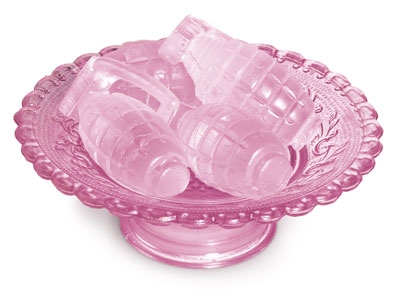
Silvia Levenson's Something Wrong? (2005)
Silvia Levenson is an international artist who was born in Buenos Aires, Argentina in 1957, lives and works between Buenos Aires and Italy. Her work is part of Fine Art Museum, Houston; USA, New Mexico Museum of Art, Santa Fe; Corning Museum, Corning USA; Bullseye Glass Company, Portland, OR; Alexander Tutsek-Stiftung , Munich, Germany and many others. She was in town this last weekend for Bullseye's BECon 2011 and Crossover so I had the opportunity sit down and talk with her.
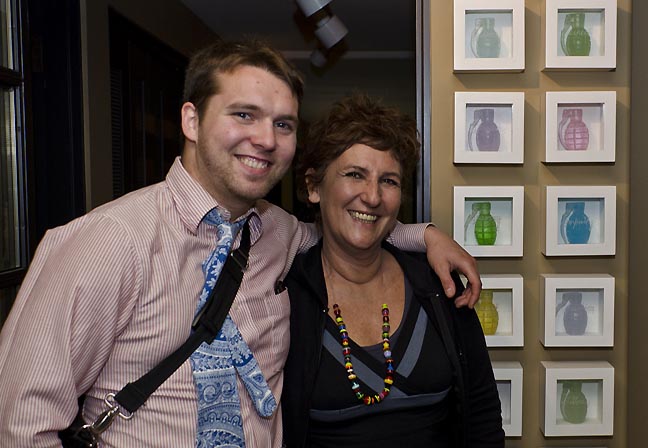
Alex Rauch and Silvia Levenson (Photo Steve C. Immerman)
AR: Your interplay between title and the work seem salient. How important is word play for your pieces? Do the titles imbue more meaning?
SL: Yes-for me titles are an important part of the work. I work in the space between reality and imagination. The title's help me extend the paradoxes between our ideas of reality and actual reality. Sometimes people say words are not important that actions speak louder than words. But I think words are very important. People have gone to war for words. Titles for me are so important because they end up as part of the work. Sometimes I add the title when I finish the work-sometimes I start with the title, and make the work after.
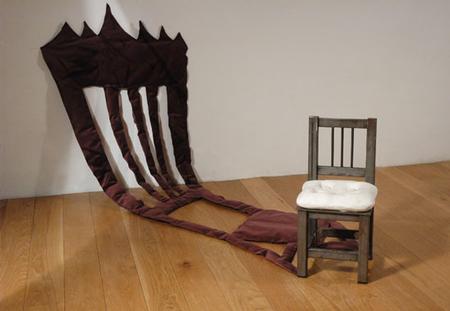
La piu bella del reame (2011)
kilncast glass, iron, velvet
38" x 30" x 41
co-created with Elizabeth Aro
AR: Your new work is as you've said, a bit of a departure for you. Your are now really focusing on childhood and less on issues of domesticity. Can you tell me a little bit about your new work?
SL: For me it was a little bit surprising when I started making the new work because I usually work a lot with social issues. This work has a lot to do with society and how you are connected to it. Like my old work this is still about expectations. And this work is more political in one sense. I started making this work - collage and cutting photos of my family, specifically of my sister, Bibi, and myself. While putting our faces over and on animal's heads I was thinking about what happens during early childhood. The inability to differentiate between what is good and what is bad. Actually, sometimes we are surprised by the cruelty of children--it is just because they are like they are. Like animals - not good or bad. The behavior of animals sometimes seems odd to a society that needs to know that everyone is good, that everyone is fine. Sometimes we are even surprised by the cruelty of pets! That animals are like they are. My new work is about the space in childhood where you don't know exactly who you are, and you are more connected with some wild part of yourself.
AR: There are a couple visual elements that came out of your new work that reminded me of cinematography. Specifically two different cinematographers-Tim Burton, and Wes Anderson-did you see "The Fantastic Mr. Fox?"
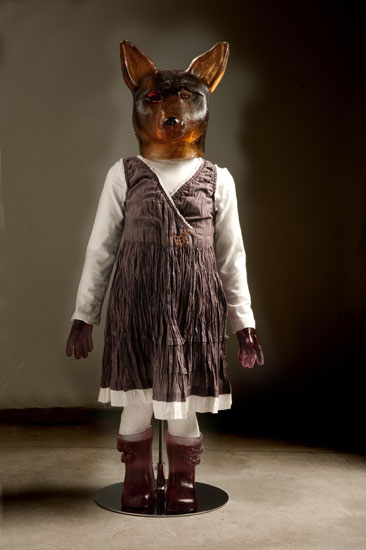
Baby Fox (2011)
SL: No, I didn't see "The Fantastic Mr. Fox" [laughs], I have to see it because the...
AR: Shadow-play seems really important in the new work-two of the pieces at least "Baby Fox" and the chair "La piu bella del reame" [ A collaborative piece with Elizabeth Aro]. The chair has an implied shadow, the lighting on the Baby Fox creates a real shadow, and even Levenson/Aro, "Drawing 1" - "Drawing 5" are mounted off the wall, which gives them a shadow. What are you saying with shadow?

Drawings 1-5
SL: Actually I'm working on that - on the shadow that is. Of course the work is a projection of objects and people in space. The work is simultaneously an empty space where you can create yourself as you want. The work is a space that is just an empty space-a free space. In the case of the chair Elizabeth Aro and myself were working with fabric the shadow is about nonsense. Of course the shadow is not normally something you can touch, but here you can touch the shadow. I think my next works, especially in collaboration with the other artist [Elizabeth] will be focused on shadows. The shadow is an empty space. It is the absence of the body or the object itself.
AR: You grew up in Argentina which is a very macho society. And then you moved to Italy, and you've been living there for 18 years?
SL: yes
AR: How has gender roles affect your life? or has it affected your life? It seem like something important within your work to talk about.
SL: Argentina is a very machismo society. When I lived in Argentina, I was involved in political activities. And I thought, when I lived in Argentina, that the feminist movement was something for rich people. It was a privilege of rich people because I thought that in South America, the women had other problems. But, when I immigrated to Italy, I met the feminists, and the feminist movement. I think that even more than now, that the feelings we have in western society is that women are spread out in all levels of the society. The idea that the media gives us is an idea that women have power in society. When you look at the actual information from Amnesty International, even in America you can see that it's not equal. I mean, every year, a lot of women are killed by their domestic partners or people that they know, and something in the society--its not just about men-I don't have anything against men, actually, [they laugh] but it's about what is happening in our society. The problem now is that we pretend to ignore what is happening. Even in really advanced societies, like in northern Europe, the violence against women is a big problem-a big issue. If you go read the Amnesty International information on the top causes of death for women, only cancer kills more women than violence.
AR: Cancer?
SL: Cancer is the first, and violence in the family or in their contacts is the second.
AR: Domestic violence?
SL: Yes. It's something that made quite an impression on me, because when I came to Italy I always thought that domestic violence was something connected to ignorance, and the problems in South America, but its not about that. It's about our society, and also about expectations. What do you think?
AR: I think it's a little bit about frustration. Try to think about world peace. Have you ever work a job where people are upset because they don't want to be there. Or a job where you have to work with people or managers you don't like. Even with out adding the element of competition just existing with the people you don't like causes anxiety. For me the future progress would be having better jobs, I guess, which would relieve a lot of these things, but even then, some people are just crazy.
SL: And I think also its about the model of happiness in our society because even the American society is the model for western civilization.
AR: American society is?
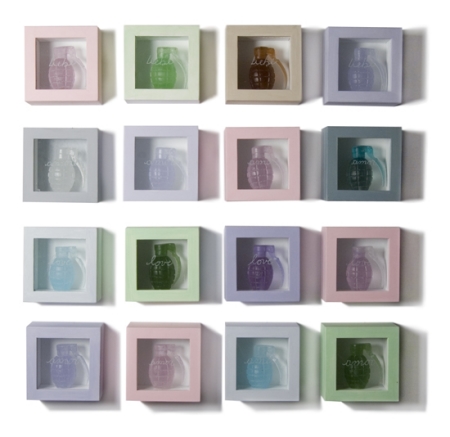
Camouflage II (2008)
SL: Yeah. And in your constitution they say that the government has to be sure that all citizens will be happy. Happiness-however you can achieve "Life, Liberty and the pursuit of Happiness." (We hold these truths to be self-evident, that all men are created equal, that they are endowed by their Creator with certain unalienable Rights, that among these are Life, Liberty and the pursuit of Happiness.)
AR: Equal pursuit of happiness.
SL: Exactly. How can you define what is happiness? I mean, if it's connected to the access to the education, and health, its fantastic, but what I see is the expectations of all people to connected to the media, and it's...
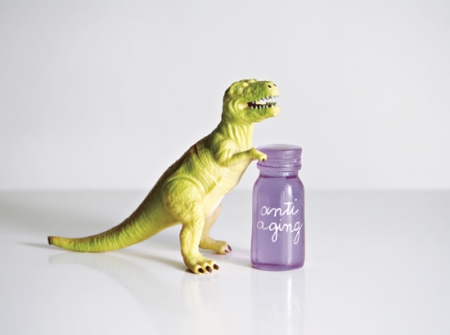
Anti-Aging (2009)
AR: Consumerism. You can buy it.
SL: Exactly. And all people expect to be happy in this way. And its not possible.
AR: Because there's only so much everyone can have.
SL: Exactly.
AR: So how do your thoughts on childhood relate to these thoughts on domesticity and domestic violence?
SL: My work is more than just domestic violence. My recent work is about the expectations of daily life that exist a short time before violence itself. Its about tension. Its when a child knows something wrong is happening but is unable to understand what. When I was a little child living in Argentina, the relationship I had with my mother-she was a victim-she suffered with violence against herself when she divorced from my father. She was in a new couple and as a little girl I was a witness to what was happening in my home as a result of violence and tensions, and my work is about that. Its about seeing something growing up that you can't control. The violence happens when people don't want to kill or beat somebody they just can't control the violence themselves (situation). And so my work is about what is whispered. What you know is coming but you don't know how to deal with it. My work, in this way, is not so feminist. I think that feminism was a fantastic movement. But my work is more about the relationship. Sometimes there is illness in the family, so its something more complicated where you can be the murderer and the victim in the same moment. This is about complicated things.
AR: The murderer and the victim?
SL: Yes. You know when you see a woman that is in a situation that is so bad for her, and she stays there anyway. Exactly that.
AR: Yeah, perception is a very interesting thing, and there are things that we want, or think we want, and then how do you fix the situation? Or do you want to fix it? How do you get somebody to want to fix the situation for themselves?
SL: The reality-what we know about reality-is our projection. How can we deal with that?
AR: Its all projection right? [laughs] How do you think about juxtaposition of materials? You could use anything, but you primarily work in glass. How do you think about materials when you're creating an object? Like when you're making your glass hand grenades, per se, or, more recently, the head [of the fox]. I mean, you can use stone, plastic or ceramic, but you use glass.
SL: Yes, I use other materials, but for the most part of my work, as you say, I use glass. I think all of us know glass because it's a domestic material. We isolate it in our houses e.g. glass in windows and doors. We use it to preserve food and we us it to drink. Its familiar to the places on our body that are so private, like the mouth. But on the other hand, in some part of our brain, we know that glass can break and can hurt us. And I like this enmity with glass. It is fragile, but its not only the fragile. I like this ambiguity between beauty and strength. When you saw my pieces they usually doesn't look so fragile. They are strong and have some mass to them, but you know that its glass anyway. So in the case of this work, for example, the fox, I use the glass in the head, in the hands, and in the boots because it's the point of contact with the external world. I didn't used to always use glass. I try to use glass when I need it. Actually I was making some videos and photos but always like the crafty part of glass. Because glass, historically, was used for decorative art, functional objects, and because I am a woman and I am using this domestic material for making art. I like it.
[Silvia apologizes about her English, again]
AR: Your English is better than my Italian. So, why/how did you start making art? Did you have a political career before your art?
SL: I didn't have a traditional art education. I was trained as a graphic designer, and actually, all my life I was painting on my own, but I didn't have any expectations about having a career as an artist. What happened was that, when I arrived in Italy, I came back to painting and I made some exhibitions with friends, and at a certain moment of my life I remember I went to visit New York. I saw an exhibition from an artist from Sweden called Bertil Valien, and I fell in love with his work and I said "I want to make things in glass." I didn't know the possibilities of glass but it was in this moment that I decided to learn how to start making objects in glass. My first pieces were just learning. More just decorative pieces, and at a certain moment I decided that in my work I would always work with the concepts I know. What I know about people. What I know in my own life. And what I know about the feelings of people who are around me. When I started exhibiting my work I wasn't so young. I was 35 years old. But because of this, I knew what I wanted. So my career... I don't like to speak about my work in terms like this, but my work as an artist went very fast [sold] and I was so surprised by that. I didn't have expectations. Which a lot of my friends that make art had a lot of high expectations about it. I come from a country where a lot of people were killed during the dictatorship including some of my friends, so I consider myself a bit of a survivor. I mean, in the end, all of us are surviving something. Then again I can just enjoy what I'm making. Not to mention that I was very lucky to have met people who loved my work very much. The same people that helped me to love my work, sell it and get it into collections. It was something akin to growing up very fast. I'm not saying that I don't know why it happened. I am very determined, I'm not a hypocrite and I know that I am very determined in what I am making is part of my life. Its also true that I maybe more accepting than other artists who had a lot of expectations about their career as artists. I'm so happy because I have the possibility to make my work.
AR: Your work is aiming to challenge people. When you create work that is intended to challenge the viewer, do you end up challenging yourself? You have these ideas you want to communicate and you end up pushing yourself further than you'd think too. Specifically with the new work.
SL: I have to say my work is very challenging. In the past, when I made a series of baby clothes using barbed wire when I finished I had the notion when I finished I said, oh my gosh too strong! I was surprised about that. And I thought, never in my life will I be able to sell these pieces, because who would want to have barbed wire in their own home? I thought to myself I had to make that. I was very surprised at the end when I saw some of these pieces. Sometimes I make pieces and my first reaction is, oh that's fantastic and other times I am afraid of them. For example, its interesting that in my relationships with people-with the public-with the viewer it is that way because my pieces are connected to my feelings. Of course my works are connected with the feelings of other people. It's not cold work. And so, usually, people come to me and speak to me about their own life. Often people say you know when I saw your piece I was thinking about this difficult moment of my life, and I saw the pink grenades and I felt. This fits so much with my life in this moment. I constantly surprised about how people speak with me about their own life. This is the mystery of the art.
AR: You're taking these ideas that are abstract, incommunicable inside of you - then trying to present it to the public. It is bigger than words.
SL: And also, the feeling when you exhibit your work is like being naked in front of people. It's the same when you write-you are showing what you are, who you are.
AR: I was thinking about the writing process and how especially dictation, is sometimes better to help the writing process out. Transcription take a while, and its not always best way to go exactly how it sounds because then there's weird punctuations, so you kind-of just have to make it work a little bit. Its close to verbatim, but not always unless you have an amazing editor.
SL: Either way it is always challenging.
AR: Silvia thank you for your time.
SL: Your Welcome. Thank you.
Transcription by Loren Nosan.


























